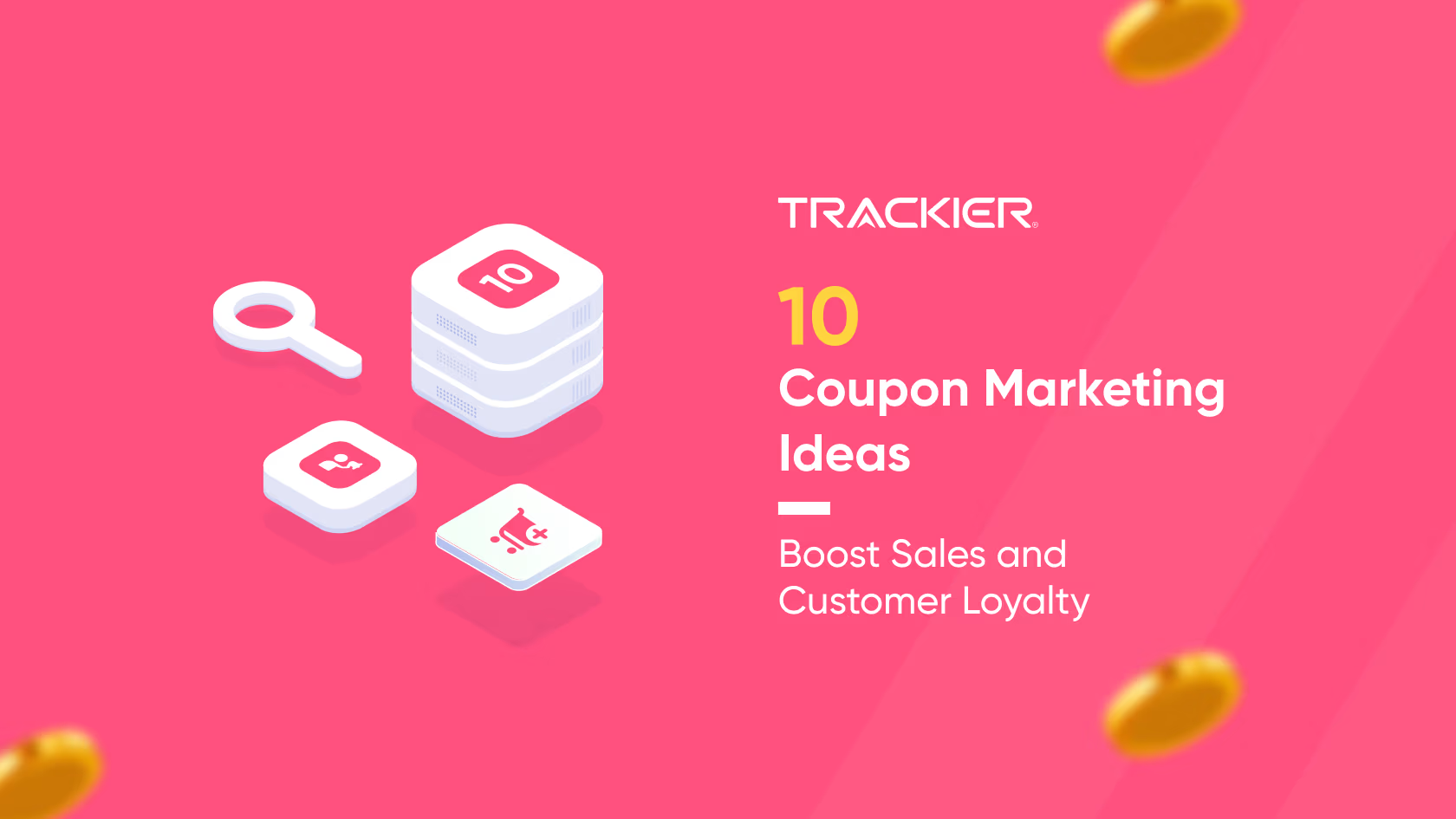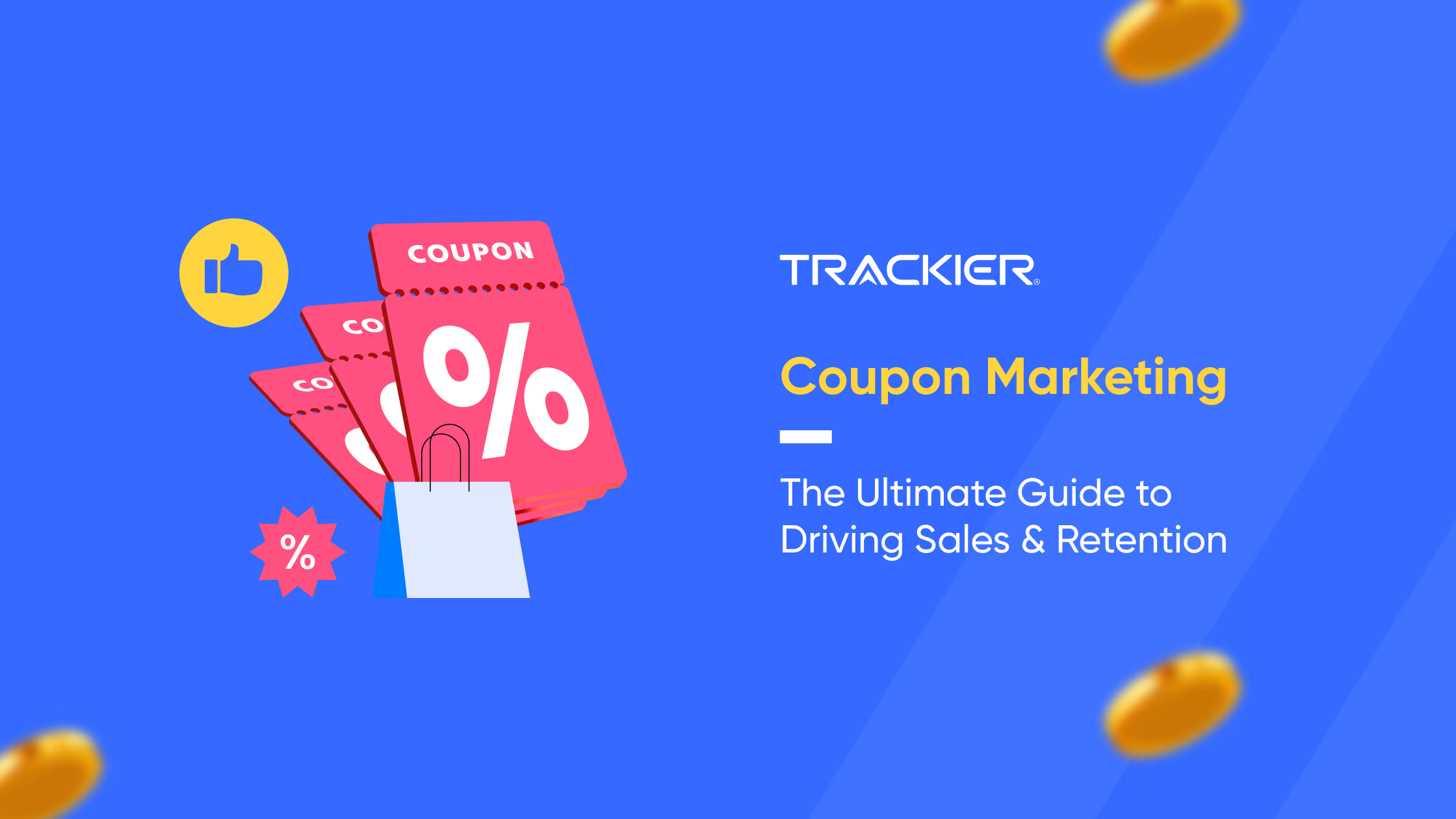What if we told you that more than 90% of consumers in the U.S. use coupons when they buy something, and 29% of consumers in India who shop online consistently search for a discount code before they buy?
That is the power of coupons. They are not just a price reduction strategy; they are an emotional trigger that allows customers to feel as if they have “won” a deal.
In performance marketing and e-commerce, some of the best coupon marketing ideas are the most common ways to drive conversions, increase customer loyalty, and maximize return on investment.
The challenge for brands is not whether or not to run coupons; it is testing new coupon code ideas to capture attention without eroding margins.
This is where Trackier helps by offering comprehensive coupon tracking, fraud prevention, and attribution. We enable coupon-based campaigns to be used towards real growth, not just random clicks.
Now, let’s explore the best coupon marketing ideas in 2025, filled with actionable marketing strategies, promo code ideas, and coupon code examples that can be implemented immediately.
What is Coupon Marketing?
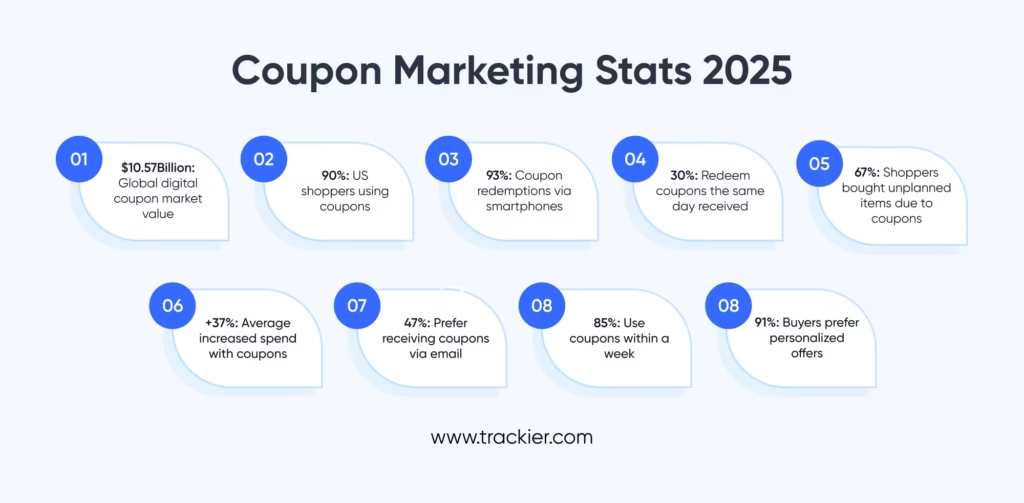
Coupon marketing is the intentional use of discount codes, referral coupons, cashback, and affiliate coupons to attract, convert, and retain customers (may leverage retention marketing for this). Coupons differ from pure discounts in that:
- Encourage urgency (“limited-time offer”)
- Reward exclusivity (“VIP only coupon”)
- Encourage social proof (influencer-specific coupon code examples)
Formats you will likely see:
- Digital codes: Entered at checkout
- Printable coupons: Still prevalent in offline retail
- Referral coupons: Double-sided “Give $10, Get $10” deals
- Affiliate coupons: Influencer or partner-specific codes tracked through Trackier smartlinks
But why does it still work? Because it causes FOMO, scarcity, and instant gratification, all these things lead to quicker conversions.
Why Coupon Marketing Still Works in 2025?
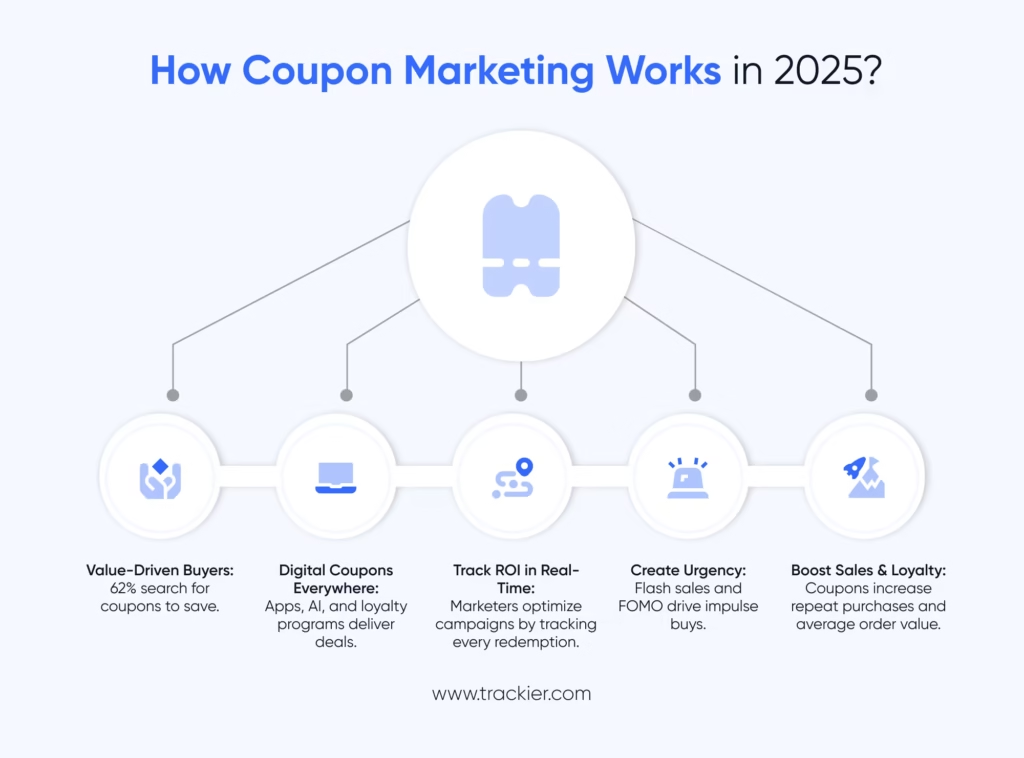
While the world of digital advertising and customer acquisition has undergone major changes, coupon marketing is still one of the most successful methods to generate sales, customer loyalty, and brand awareness in 2025.
The reason is simple: customers still love bargaining, but the way they find and redeem coupons has changed.
1. Buyers Are More Value-Driven Than Ever
Global inflation and the increasing cost of living have changed buyers’ behavior. 62% of U.S. consumers actively search and use promo codes, discounts, or coupons when making online purchases.
While 59% use Google or other search engines to find discount codes before making an online purchase.
Example: Target’s “Click Week” campaign in 2024 resulted in a 23% week-over-week increase in mobile app daily active users during April 2024, along with a significant increase in sales, membership growth, and repeat purchases from existing customers.
2. Digital Transformation of Coupons
Coupons are not just cut-outs in the newspaper anymore. By 2025, coupons will be integrated into apps, loyalty programs, influencer campaigns, and even AI-powered personalized offers.
The growing importance of digital coupon strategies, emphasizing how digital platforms are enabling businesses to engage customers more effectively, personalize offers, and enhance the overall shopping experience through innovative technologies and mobile-first approaches.
3. Performance Marketers Can Easily Track ROI
Rather than blindly discounting using traditional discounting, now coupon campaigns can be tracked all the way down to the last click.
Using Trackier’s platform, marketers can view coupon attribution, which affiliates have generated the most redemptions, and analyze their ROI in real-time. This allows marketers to turn coupons from sometimes ‘blind discounts’ to performance-driven cost-cutting strategies.
Industry data shows that typically the top 20% of affiliate partners drive almost 80% of total affiliate channel growth, which is why coupon tracking solutions like Trackier help eCommerce brands identify and nurture their highest-performing partners.
4. Coupons Drive Impulse Buying
Coupons create scarcity and urgency; in some instances, it may be flash sales or limited-time codes, with FOMO being the reason to make coupons a highly effective method of conversions in 2025.
Many consumers end up buying something they hadn’t planned, simply because they find a coupon or discount.
Top 10 Coupon Marketing Ideas That Work in 2025
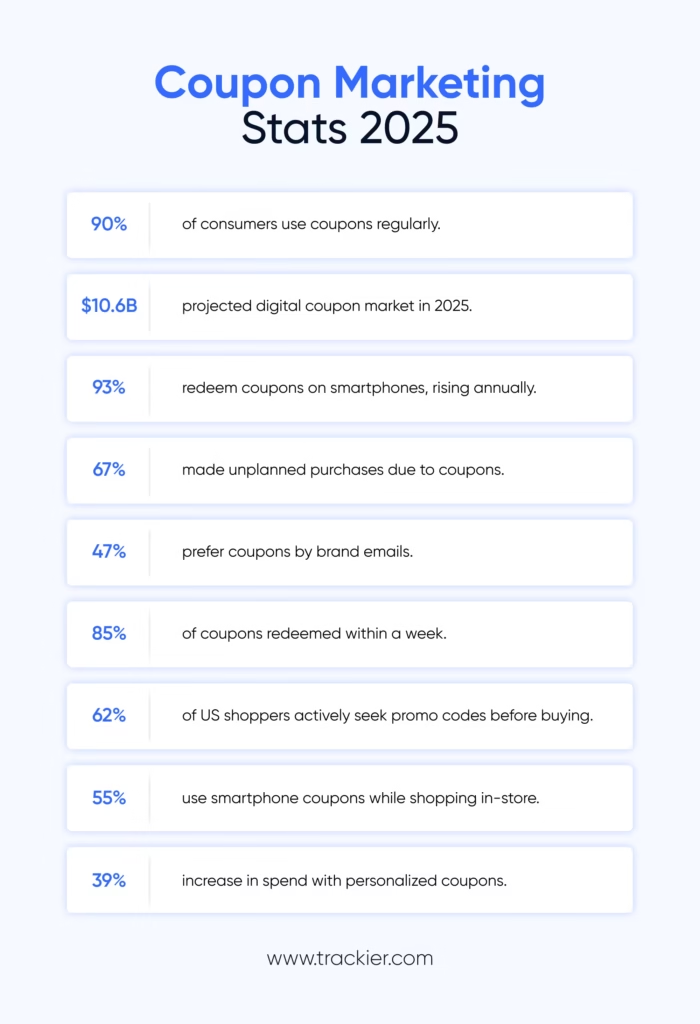
Coupons remain one of the most effective ways to attract new customers, boost conversions, and encourage repeat purchases. In fact, more than 90% of U.S. consumers used at least one coupon in the year.
For performance marketers and e-commerce brands, smart coupon marketing ideas can drive incremental growth without burning margins.
Here are 10 actionable coupon marketing ideas that are backed by examples, fresh stats, and proven tactics that you can adapt to your campaigns.
1. First-Time Customer Discounts
Use an exclusive coupon for new users to encourage them to convert faster. As per the report, 64% say discounts speed up their decision to buy.
A nice example would be Nike gives 10% off to first-time app users to drive installs and sales. Also, welcome offers are among the most effective coupon code ideas for attracting first-time buyers.
However, to track which coupon codes or promotions drive first-time purchases, and to which source they should attribute them, leverage Trackier’s marketing analytics.
2. Flash Coupons
The urgency of short-term coupon marketing ideas, which provide immediate rewards, creates urgency and thus drives action. Experimenting with different promo code ideas like percentage-off, BOGO, or free shipping can boost engagement.
For example, as per the report, 62% of shoppers delay clothing purchases until a discount is offered, which highlights the impact of discount timing.
A real-world example would be: Amazon’s Prime Day “Lightning Deals”, which automatically advertised sales with countdown timers.
So, for you, the important tip would be to add countdown banners on the landing page to create an urgency.
3. Holiday and Seasonal Coupon Campaigns
Holidays are a great opportunity to take advantage of the higher purchase intent, as seasonal promo code ideas are the best to maximize impact. U.S. ecommerce holiday sales grew 8.7% to $241.4 billion in 2024, with further growth expected in 2025.
One of the best examples would be: Starbucks has created BOGO holiday drinks to encourage in-store visits during the holiday season.
4. Referral Coupons
Give both the referrer and the referee a discount, like a simple promo code idea such as ‘FRIEND10’, to make referral sharing effortless and effective.
According to Wharton Business School, referred customers have a 16% higher lifetime value than non-referred customers.
For example, Dropbox’s referral coupons (aka extra storage) helped them grow their user base from 100,000 to 4 million users in 15 months with a 3900% growth.
5. Influencer and Affiliate Coupon Codes
Partner with influencers and affiliates who distribute personalized coupon codes. 89% of marketers say that influencer marketing achieves an ROI at least as good as other methods.
For example, Gymshark grew internationally by giving influencers special discount codes that led to trackable sales, or we can say Gymshark’s influencer-specific coupon code examples highlight how personalized offers drive measurable sales.
The cool thing about coupon tracking is easy, avoids fraud, and optimizes payments to partners.
6. Gamified Coupon Campaigns
Make coupons a fun experience, creative coupon code examples like spin-to-win rewards keep campaigns interactive and fun.
An example would be: Sephora is very active with their gamification with rewards and surprise coupons for their loyalty program.
So, one of the most effective tips would be, use gamified coupons with exit intent popups to reduce cart abandonment and increase sales.
7. Tiered Spend Coupons (Spend More, Save More)
Encourage high cart value and reward customers who spend huge money. Tiered discounts encourage larger purchases by offering increasing discounts as customers spend more, effectively driving up AOV through strategic spending thresholds.
Our tip would be, use a comprehensive campaign report to determine if the tiered coupon codes are driving incremental revenue or just discounting existing sales.
8. Geo-Targeted Coupons
Geo-targeted coupons are most effective for location-specific consumer campaigns. In fact, 80% of consumers are more likely to purchase when brands personalize their experiences.
A good example would be Uber Eats runs city-specific coupon code examples such as “₹150 off in Bangalore”, ensuring hyperlocal engagement with customers.
The tip would be, consider offering geo-targeted coupons in conjunction with regional festivals/events to make the offer even more contextual.
9. Exit-Intent and Cart Abandonment Coupons
When consumers are about to exit, it’s the last best opportunity to capture lost revenue; hence, a discount can be offered to entice users to stay.
An example: ASOS will show a discount pop-up, such as 10%, if a user tries to leave but pauses due to products left in their cart.
Hence, you should use coupon attribution to identify how much of the revenue was recovered by using coupons as exit-intent offers. If you do not know how you do it, you can read our blog on how to make promo codes work for you.
10. Subscription and Loyalty Coupons
Use exclusive coupon code ideas, like birthday discounts, to build strong brand affinity. A 5% increase in customer retention can increase profits by 25% to 95%.
A good example: Amazon Prime members regularly receive coupons for Whole Foods and Kindle to keep Prime members, as if they’re in a waiting game.
So, the tip would be: for long-time customers, consider offering higher-value coupons than for one-time buyers.
Best Practices for Running Coupon Campaigns
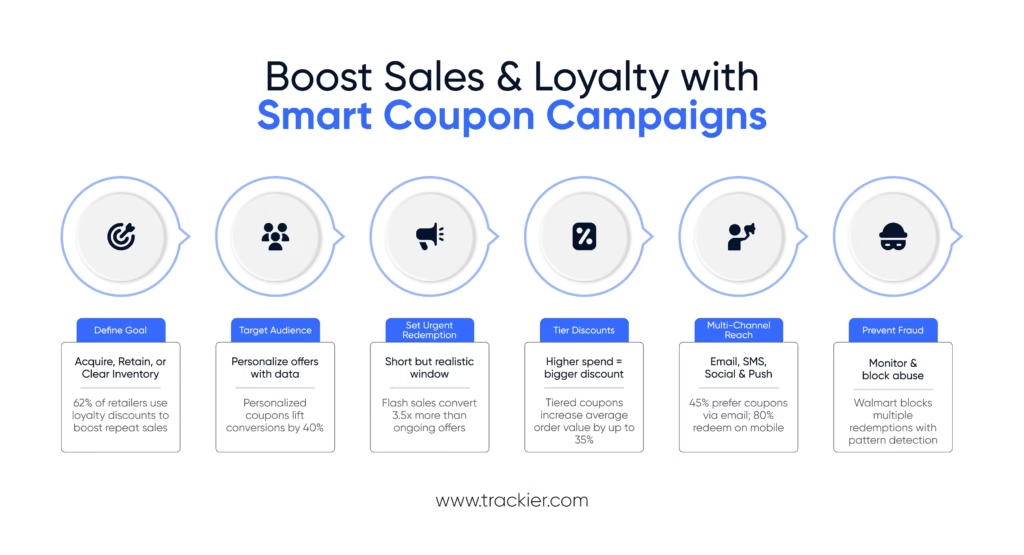
When executed properly, coupon marketing not only provides huge sales during the campaign but can also begin to build long-term customer loyalty. Here are the steps to execute the campaign’s full potential:
- Clarity of Objective – Be clear about whether your campaign goal is customer acquisition, customer retention, or limited inventory clearance. For instance, on customer retention, Sephora sends exclusive birthday coupons, while on the other end of the spectrum, Amazon Lightning Deals are typically urgent sales and clearing out inventory.
- Audience Segmentation – Leverage data-driven audience segmentation to create personalized offers. For example, Nike provides app-only coupons for its member users, which reward loyalty and enhance app engagement.
- Set Meaningful Redemption Periods – Establish urgency by providing a redemption period that is short but realistic for your customers to redeem. A classic example of campaign urgency vs brand identity is Domino’s Pizza’s long-standing campaign of “30 minutes or free”. Urgency accomplished more redemptions without overriding the brand.
- Higher Tier Level Discounts – Encourage higher basket sizes using higher tier level coupons. For example, if you provide coupons for 10% off orders above $50 and 20% off for orders above $100. McDonald’s coupons in their apps regularly bundle meals and provide discounts at varying price points to increase the average order value.
- Enable Multi-Channel Distribution – Avoid limiting coupons to one channel; share them out via email, SMS, push notifications, and social media. As per Statista, 34% of U.S. buyers found the coupons digitally, making omnichannel necessary for brand promotions. Testing multiple promo code ideas helps brands identify what resonates most with each audience segment.
- Prevent Coupon Abuse and Fraud – Abuse of coupons can decrease profit margins. Many brands now leverage fraud prevention software to identify multiple redemptions from a single consumer. For instance, Walmart uses coupon redemption patterns to disallow fraudulent claims while protecting its margins.
Evaluating the Effectiveness of Your Coupon Campaigns
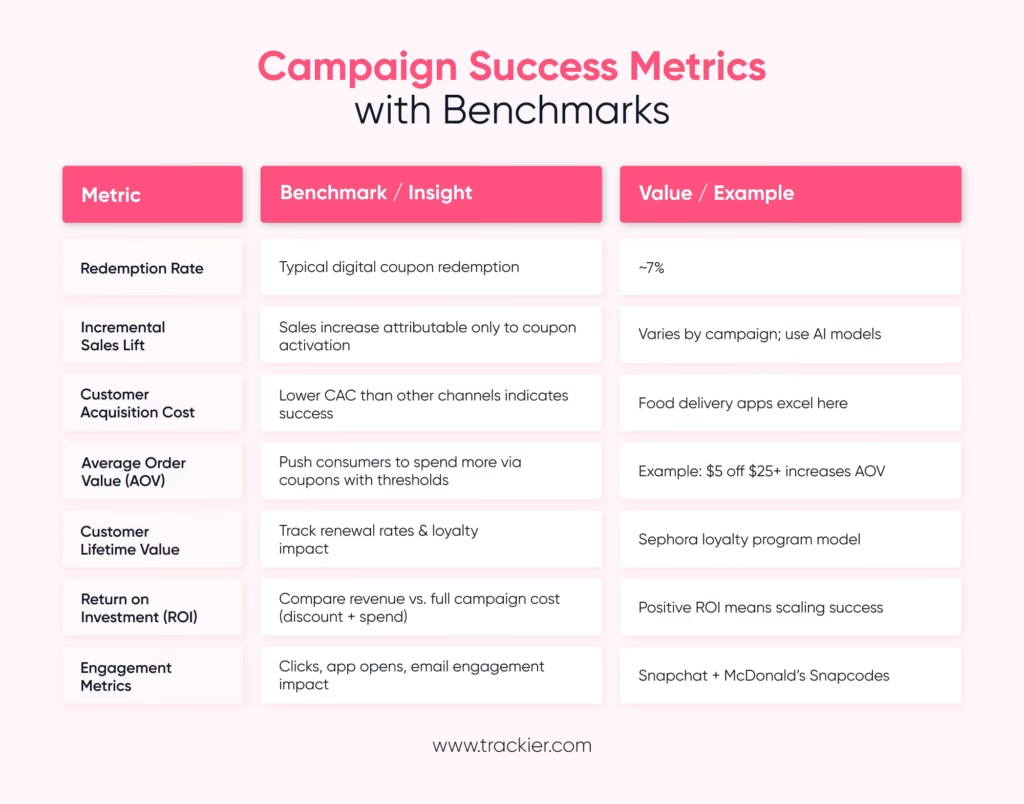
Coupons are only helpful if we are able to measure their true impact. Tracking different coupon code ideas ensures only high-performing campaigns scale profitably.
However, there are success metrics available in terms of the old ones, as well as insights into new advanced measures. Let’s look into it:
1. Redemption Rate
The redemption rate tells you how many of the coupons that you distributed were ultimately redeemed.
A typical redemption rate for digital coupons averages around 7%, significantly higher than traditional coupon formats.
Many of Starbucks’ app coupon offerings achieve a higher redemption rate. However, this may be due to their loyalty program.
2. Incremental Sales Lift
Coupons should primarily drive new sales, rather than discount your existing sales.
Many brands utilize AI to measure incremental lift by ensuring coupons are utilized on purchases that would not have happened otherwise.
3. Customer Acquisition Cost (CAC)
CAC is useful to compare the cost of executing the coupon campaign versus the number of new customers that were acquired or raised awareness for your brand.
If the CAC is lower than other marketing channels combined, then your coupon marketing campaign is a success.
First-order coupons are often utilized by food delivery apps like Zomato and Swiggy, allowing them to acquire new customers at scale.
4. Average Order Value (AOV) Increase
One way to structure coupons is to push consumers to spend more. For example, you can offer a coupon of $5 off a purchase of $25 or more, with the intention of increasing the size of a basket from empty to $25.
If the AOV increases during the coupon campaign, then your coupon strategy is working.
5. Customer Lifetime Value (CLV) Growth
A successful coupon campaign should not just be about attracting one-time deal-seekers.
By tracking renewals, brands are able to determine whether the coupons improved long-term loyalty. Sephora’s loyalty program coupons are a good example of CLV-based couponing.
6. Return on Investment (ROI)
Compare total revenue against total campaign spend (discount + distribution cost). A well-optimized coupon campaign can generate significant returns by boosting conversions, average order value, and customer loyalty.
7. Engagement Metrics
Review clicks, app opens, and email engagement to measure how coupons impacted brand engagement.
Snapchat’s “Snapcodes for coupons” program with McDonald’s offered an example of how interactive coupons can influence both engagement and sales.
Conclusion
Coupons aren’t just discounts. If done correctly, it will:
- Convert one-time customers to loyal buyers.
- Provide a retention strategy for loyal customers.
- Maximize the return on investment (ROI) for your campaigns.
- Smart promo code ideas can be the difference between one-time discounts and long-term customer loyalty.
If you’re serious about scale, your next step is simple:
- Plan smarter campaigns.
- Track performance with precision.
- Get rid of fraud.
That’s where Trackier comes in. From coupon code attribution, fraud detection, to performance reporting, Trackier provides you with the tools to turn your coupon campaigns into growth.
Don’t wait – Get started today! Book your free demo and discover how Trackier can increase your coupon marketing ROI.
FAQs
1. What is a coupon marketing strategy?
A coupon marketing strategy is the strategic use of promotional discounts, promo codes, or vouchers with the goal of attracting, converting, and retaining customers. There is a process to it, as there are campaign goals to clarify, audiences to target, and how the coupon redemptions will be tracked.
2. How to make a good coupon?
A good coupon is clear, has value, and is time-limited. In general, a coupon should have a simple code to copy and paste, an attractive discount, and a redemption period that is not ridiculous. The use of personalization, for example, targeting specific audiences (new users or loyal customers), can make even a good coupon more effective.
3. How to market discount codes?
Discount codes can be marketed through many channels, including email campaigns, SMS alerts, push notifications, social media posts, influencer partnerships, and affiliate campaigns. Couple that with various strategies (urgency, flash sales), personalized codes (geo-target), and exclusivity (VIP only), and you’ll have even better consumer engagement.
4. What are the two kinds of coupons?
Coupons are discussed in the context of two different types: digital and physical. Digital coupons include promo codes, mobile app vouchers, and referral codes. Digital coupons have less cost associated as it is relatively easy to distribute and track. Physical coupons are printed vouchers often used for retail. Physical coupons will always remain a community outreach option.
5. How to promote your promo code?
Advertise promo codes through interactive content and multi-channel campaigns. Leverage social media ads, affiliate tracking, influencer partnerships, email newsletters, and many other tactics. Adding countdown timers is a good way to add urgency, and personalizing offers based on customer actions is also a great way to increase engagement.
